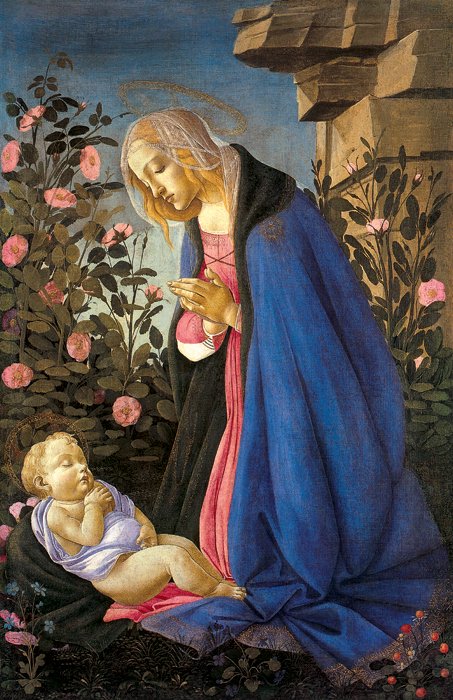Botticelli’s First Works
26. The Virgin Adoring the Sleeping Christ Child, c. 1490.
Tempera and gold on canvas, 122 x 80.3 cm.
National Gallery of Scotland, Edinburgh.
There are three distinct aspects in Botticelli’s works that correlate to three very different emotional states: the moderate serenity and originality of the first years during the Medici period; Botticelli’s Pagan crisis, a voluptuous vision that nonetheless did not affect the religious idealism in pictures of sainthood that he painted during the same time; then, towards the end of his life, a truly romantic inspiration, like a conversion to a sombre Christianity, when he joined Savonarola’s sect and renounced the genius of the Renaissance.
It would be foolish to try to determine the precise years of these three phases, which are separated by nuances of sentiment, rather than by painting methods. They are a sort of steady evolution of Botticelli’s distinct aesthetic. The critical method, which seems to work for Raphael, would only yield uncertain results for Botticelli. One can date most of Raphael’s works with certainty. For Botticelli, however, a rigorous historical catalogue is difficult to establish. Some paintings can be classified rather plausibly thanks to the events surrounding them. Only one bears the evidence of the year it was completed. It is the last one, the astounding Mystic Nativity, which is in the possession of the National Gallery in London and can be dated to 1500.
Botticelli’s phase of Pagan idealism falls into the period of Lorenzo the Magnificent. But even here one must beware of too strict a chronology. The poetic seduction of the court and of Medici society doubtlessly left its mark on the young painter’s imagination after his farewell from his master Filippo Lippi in 1469. It would continue until Lorenzo’s death in 1492. Botticelli’s first stay in Rome took place sometime during this period (approximately 1481-1482). Even though this visit hardly lasted a year, it was not without importance. This was the anti-Christian Rome of Sixtus IV, the Bestia senza pace, fierce enemy of Florence, the Rome of the she-wolf, Alighieri’s haggard she-wolf, “brimming with all sorts of lust, which makes so many people live in sadness.” He retained impressions of religious anxiety, which would later lead this follower of Dante on his way to the apocalyptic religion of Girolamo Savonarola. He was thus, until his end, the nervous child that the honest Vasari described, a wavering personality that often shirked his duties, an enigmatic, alluring figure, like the mysterious creatures that slither through the half-light of his paintings.
